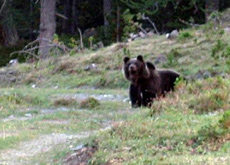Ibex is king of the mountain in 2006

Switzerland's largest nature conservation organisation, Pro Natura, has designated the ibex – which features on its logo – as its animal of the year in 2006.
This year marks the centenary of the reintroduction of the ibex into Switzerland after it was hunted into extinction at the beginning of the 19th century.
“For me the ibex invokes wisdom, courage and tenacity. It has a slow, steady and majestic gait because it lives in difficult terrain all year round,” explained Paul Demierre, head of canton Fribourg’s hunting and fauna department.
The ibex, a type of wild mountain goat with large curved horns, disappeared from Switzerland in 1809.
Capra ibex, to give it its Latin name, was hunted not only for its meat but also because of the medicinal properties attributed to various parts of its body, including curing sexual impotence.
At the time there were only a few dozen ibex surviving worldwide, living in the private hunting grounds of King Vittorio Emanuele II of Italy in the Aosta valley.
Attempts by two members of the Swiss government to buy young ibex failed after the king opposed the idea.
Breeding programme
Efforts from 1875 to breed a kind of hybrid of ibex and goat ended in failure but in 1906 a solution to the problem was found, albeit an illegal one.
With financial support from the Swiss interior minister, zoologists from St Gallen asked poachers in the Aosta valley to supply them with purebred animals.
The poachers “acquired” two ibex females and a male from the king’s hunting grounds and brought them to Switzerland.
They were bred successfully in zoos until some were released in the wild in the area of the Graue Hörner, canton St Gallen, from 1911.
Today Switzerland has an ibex population of about 14,000 and while hunting is now permitted, this takes place under strict controls.
For Demierre, the main point is that the reintroduction of an animal that was practically extinct has been a significant success.
“The history of the ibex shows that nothing is ever lost and that an animal that had been massacred by man can be reintroduced with protective measures.”
swissinfo with agencies
Resident in Switzerland for 18,000 years, the last native ibex was killed in 1809.
The government had tried unsuccessfully from 1875 to acquire ibex from Italy by legal means.
In 1906 poachers illegally brought to Switzerland two females and a male from the Gran Paradiso, the hunting grounds of the Italian monarch.
The first ibex were released in the wild in Switzerland from 1911 and are now the most populous horned animal in the Alps.
They number 14,000 in Switzerland and since 1977 it is permitted to hunt them under strict control. Specialists keep a close eye on them because some colonies are stagnating or dwindling in number.
There will be a ceremony on June 22 commemorating the decision by Swiss zoologists to reintroduce the ibex illegally from Italy, after King Vittorio Emanuele II refused to sell them to Switzerland.
Several events are planned, including the issue of a postage stamp, publication of a book and an international congress entitled “Ibex 2006”, organised by the federal environment agency, ChasseSuisse (hunters), Pro Natura, the Swiss Alpine Club and ZooSchweiz.
The Swiss government is symbolically offering 40 ibex to Italy.

In compliance with the JTI standards
More: SWI swissinfo.ch certified by the Journalism Trust Initiative













You can find an overview of ongoing debates with our journalists here . Please join us!
If you want to start a conversation about a topic raised in this article or want to report factual errors, email us at english@swissinfo.ch.